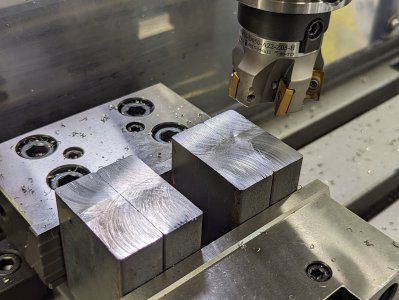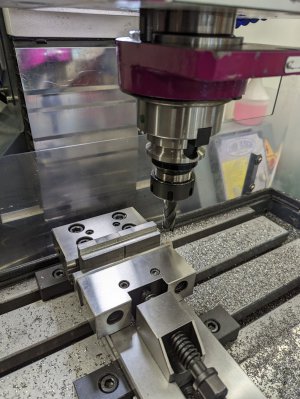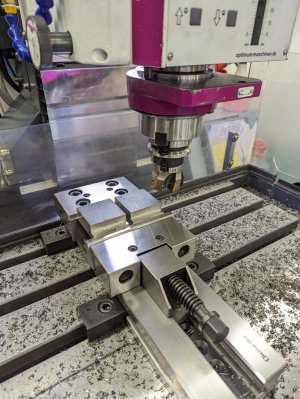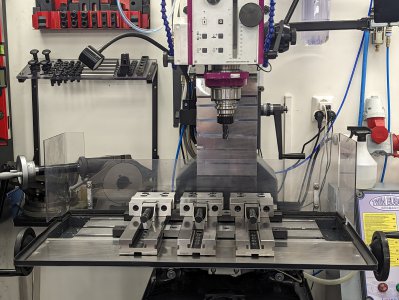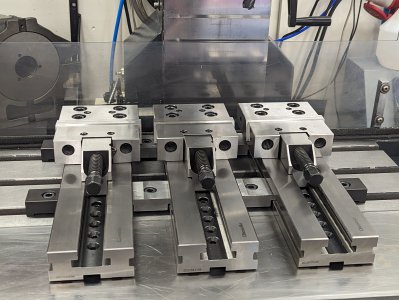-
Welcome back Guest! Did you know you can mentor other members here at H-M? If not, please check out our Relaunch of Hobby Machinist Mentoring Program!
You are using an out of date browser. It may not display this or other websites correctly.
You should upgrade or use an alternative browser.
You should upgrade or use an alternative browser.
Optimum MH 50V mods and accessories
- Thread starter Unlogic
- Start date
After some detective work as to why some parts I made always were slightly out of spec I realized that the coulmn of my milling machine was leaning.
Compared to many other smaller models the bolts for the column on my machine are on the underside which makes the job of aligning it a bit tricky.
I ended up lifting the machine of the stand.
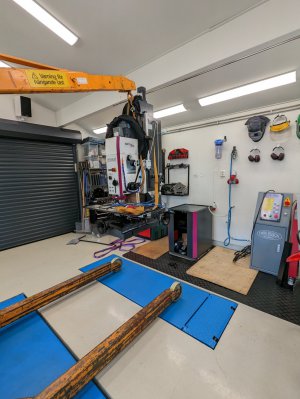
And then drill holes in the stand so that I could access the bolts for the column.
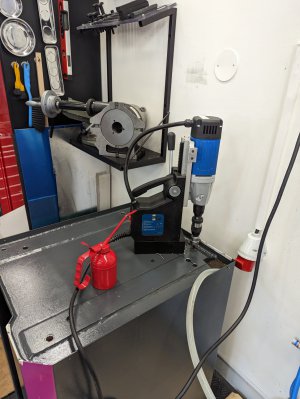
I still have the stand from the slightly smaller Optimum MH 30V machine I initially ordered.
The machine I have now is slightly bigger in all dimensions and therefore sticks out both behind and infront of the stand.
I've previously use two bars of 10mm thick steel to lift the machine up over the edges of the stand but these did not extend extend the full depth of the machine.
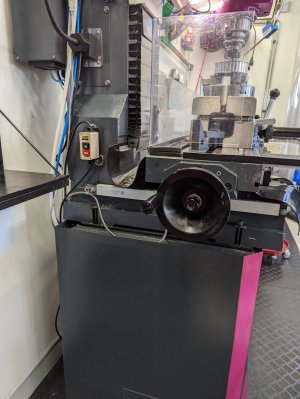
I decided to do something about it so a while ago I prepared two new longer bars out of 15mm thick steel.
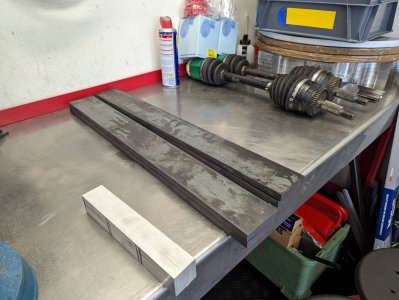
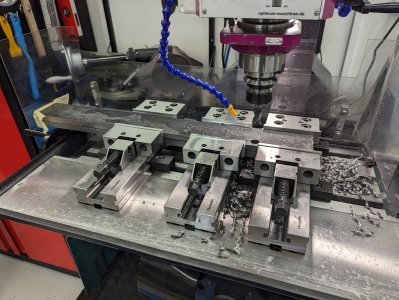
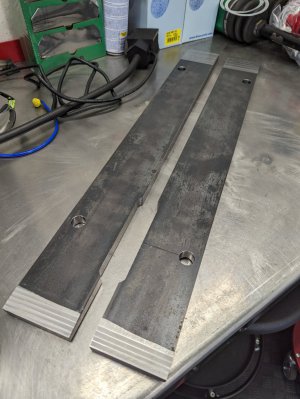
I then grinded down the edge of the stand slightly so that the bars could protrude outside the edge of the stand. The slight chamfer on the edges it to ensure that any excess lubrication oil runs back into the stand.
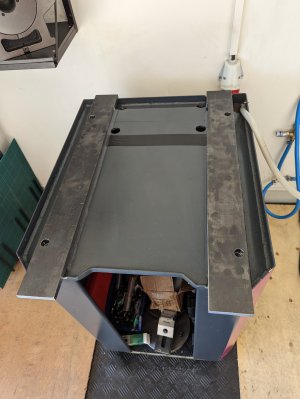
This is how it looks with the machine installed.
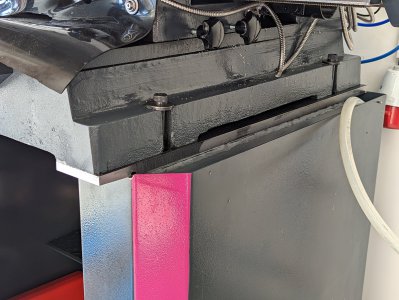
Compared to many other smaller models the bolts for the column on my machine are on the underside which makes the job of aligning it a bit tricky.
I ended up lifting the machine of the stand.

And then drill holes in the stand so that I could access the bolts for the column.

I still have the stand from the slightly smaller Optimum MH 30V machine I initially ordered.
The machine I have now is slightly bigger in all dimensions and therefore sticks out both behind and infront of the stand.
I've previously use two bars of 10mm thick steel to lift the machine up over the edges of the stand but these did not extend extend the full depth of the machine.

I decided to do something about it so a while ago I prepared two new longer bars out of 15mm thick steel.



I then grinded down the edge of the stand slightly so that the bars could protrude outside the edge of the stand. The slight chamfer on the edges it to ensure that any excess lubrication oil runs back into the stand.

This is how it looks with the machine installed.

With the machine back on the stand I started the process of tramming the machine.
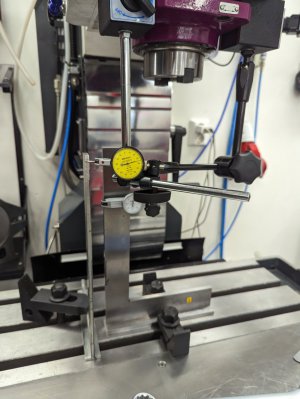
I ended up having to add shims to three of the four bolts for the coulmn and one shim for the head itself which was noding a bit.
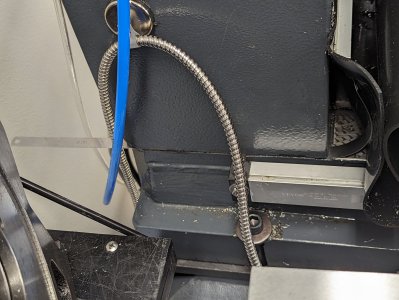
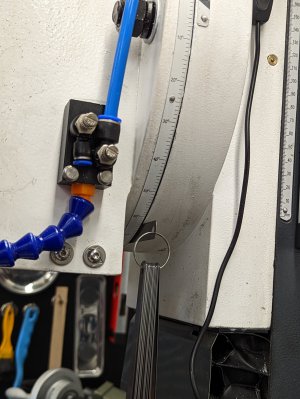
In order to lift the column slightly so that I could insert the shims I used a wooden block between the casting of the head and the table.
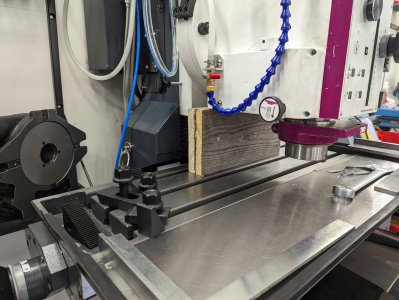
In order to get a gap between the head and the column I placed two machine wises between the front casting of the head and the table.
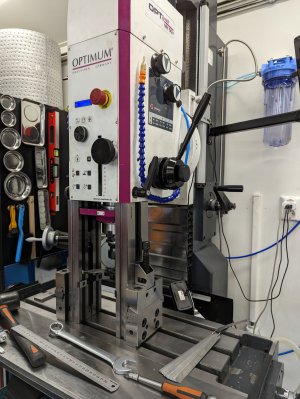
While doing the tramming I realized that the milling table was about as flat as the Himalayan mountains...
So I ended up stoning the table quite a bit.
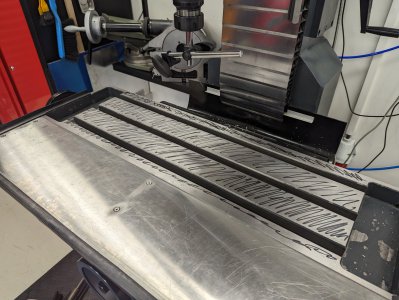
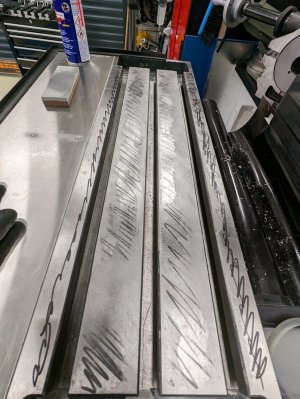
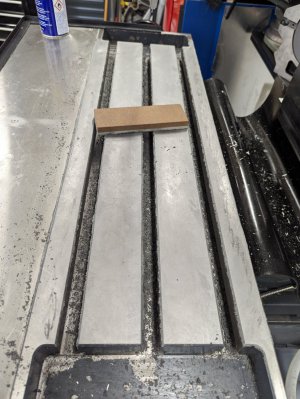
The table isn't perfect but it will have to do for now as I wore down the stone almost completely

I ended up having to add shims to three of the four bolts for the coulmn and one shim for the head itself which was noding a bit.


In order to lift the column slightly so that I could insert the shims I used a wooden block between the casting of the head and the table.

In order to get a gap between the head and the column I placed two machine wises between the front casting of the head and the table.

While doing the tramming I realized that the milling table was about as flat as the Himalayan mountains...
So I ended up stoning the table quite a bit.



The table isn't perfect but it will have to do for now as I wore down the stone almost completely
- Joined
- Jun 12, 2014
- Messages
- 4,810
Getting the columns leveled is always an issue with these types of column mills. Also, given the weight of the mill head the gibbs are going to wear on the bottom quicker than top and cause some head nod over time. I have seen a number of Optimum owners add a counterbalance system either chain/sprocket or cable/pulley system to decrease the head weight and pull up on the back head mounting plate. Might be something to look at.
Thanks for the good advice mksj. I had actually not reflected over the accelerated gib wear at the bottom of the head, but it makes total sense.
Without some type of counterweight it's gonna be inevitable to have uneven gib wear on the z-axis. A pure counterweight is obviously going to be the simplest to balance but with the downside of increased mass leading to reduced speed during in CNC operations. Gas springs don't increase the mass but I suspect the don't provide equal balance across the full range and that they might be harder to balance properly.
Without some type of counterweight it's gonna be inevitable to have uneven gib wear on the z-axis. A pure counterweight is obviously going to be the simplest to balance but with the downside of increased mass leading to reduced speed during in CNC operations. Gas springs don't increase the mass but I suspect the don't provide equal balance across the full range and that they might be harder to balance properly.
Yes. mine is cnc on all axis.By the way is that a CNC conversion on the X-axis?
Sorry for the late reply. But looks like you where quite busy
I had some trouble with my machine as oil was comming down the spindle. Since I had to change the oil-seal I decided to change all bearings as well and this was quite a journey.
Getting the bearings was not a problem since lukas allready listed them in is thread on the german site. But the upper spindle bearing was really hard to find.
Reassembling went fine and everything worked great, but only for a day or two. Then the oil started dripping again.
Turns out that the oil seal was installed backwards by the factory and i went along with it, without much thinking during reassembly.

The only thing that was a bit strange was that the bearing inside the gearbox reached about 100°C when I looked at it with a theramal camera.
So the second time changing the seal was way quicker since i allready had experience

And this time I went with a better seal for higher temperatures but since the seal was put in the right way the bearing didn't get as hot.
If you don't have done it allready I really recommend an oil change. The factory oil was really a brown stinking soup.
And if you need pictures from inside the gearbox, I have lots of them
- Joined
- Jun 12, 2014
- Messages
- 4,810
Similar to the problems you have had, I also had that with my previous Optimum mill. The spindle ran extremely hot if run at the higher speeds for any length of time, to the point you couldn't touch the bottom of the spindle/head for more than 1-2 seconds. It was also shy of its rated top speed by about 100 RPM. You could see a lot of foaming of the oil as well as a lot of particles. When I changed the oil, it was very heavy with iron particles, and not very pleasant. I replaced the oil with a full synthetic gear oil, the spindle temperature was decreased significantly, less foaming of the oil and I gained full top speed. So the stock oil should be changed soon after the mill is broken in. Use of a synthetic was a significant improvement, and oil foaming dissipated much more quickly in the site window.
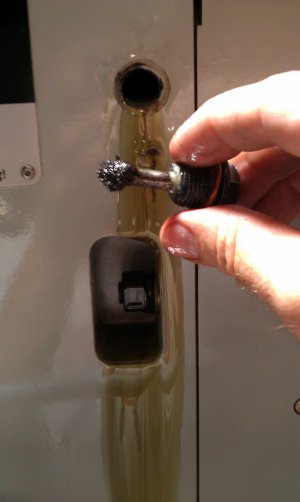

@mksj The foaming is IMHO due to the recommended oil level. When I put my gearbox together I added the oil before the top lid was screwed down. So I saw that the oil level is right on the edge of the spindle gears. So when the spindle rotates with 3000rpm it's like a mixer...
The second time I put everything together I added significantly more oil and mounted a hose on the oil-screw leading into a bottle to catch the excess oil.
I also had lots of iron in the oil but i think most of it was from assembly in the factory. I also found casting sand inside - so cleaning everything out was a good idea.
Assembling the spindle took most of the time since I didn't know what the right bearing pressure was, so I had to let it run for 2 hours check temperature of the spindle, get it out again, screw the bearings a bit more together, repeat run,.....
It now gets to about 60°C even at a high load in steel and 3h continously. So I'm happy for now.
And thank you for your tip with the counterweight. I will also need something like this.
The second time I put everything together I added significantly more oil and mounted a hose on the oil-screw leading into a bottle to catch the excess oil.
I also had lots of iron in the oil but i think most of it was from assembly in the factory. I also found casting sand inside - so cleaning everything out was a good idea.
Assembling the spindle took most of the time since I didn't know what the right bearing pressure was, so I had to let it run for 2 hours check temperature of the spindle, get it out again, screw the bearings a bit more together, repeat run,.....
It now gets to about 60°C even at a high load in steel and 3h continously. So I'm happy for now.
And thank you for your tip with the counterweight. I will also need something like this.
Big thanks for all your input and feedback @gschora and @mksj. I've not had any problems with oil leaks but I've seen the oil foams like crazy at high speeds.
I've thought about replacing the oil but couldn't find anyone selling the oil recommended in the manual. Which type/brand/weight of gear oil are you using?
I've thought about replacing the oil but couldn't find anyone selling the oil recommended in the manual. Which type/brand/weight of gear oil are you using?


